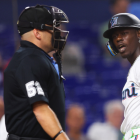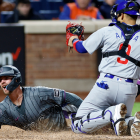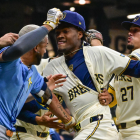The Los Angeles Dodgers didn't do much at the trade deadline. In fact, just one of the five players they acquired in July deals was deemed good enough to crack their National League Divisional Series roster: left-handed reliever Adam Kolarek, who joined the Dodgers having accumulated a 103 ERA+ in 86 innings thrown over parts of three big-league seasons.
Kolarek didn't seem to be a big addition at the time, but he's since proved to be a valuable, if not voluminous member of the Dodgers' postseason plans.
To wit, Kolarek has appeared in each of the Dodgers' first three postseason contests against the Washington Nationals. Each time he's faced just one batter -- literally, the same batter: phenom outfielder Juan Soto. Here's how those three faceoffs have gone:
Game 1: Kolarek struck out Soto on three pitches to lead off the seventh inning.
Game 2: Kolarek won a nine-pitch battle with Soto up and two runners on in the eighth.
Game 3: Kolarek fanned Soto, this time on six pitches to begin the bottom of the eighth.
That's three appearances, three batters faced, and three outs on 18 pitches.
Kolarek's usage shouldn't surprise anyone who paid attention to how the Dodgers used him after the trade. Whereas the Rays didn't go full hilt on him as a specialist, permitting him to face more right-handers than lefties, the Dodgers deployed him as an old-school LOOGY -- or, left-handed one-out guy. As a result, Kolarek finished the regular season having appeared 26 times with the Dodgers and completed fewer than 12 frames.
To be clear: Kolarek's role is one he seems best fit to fill. For his big-league career, he has a .524 OPS against lefties and an .849 mark against righties. He throws from a side-arm slot -- a commonality for specialists -- and he's primarily a fastball pitcher, which is notable given his sinker sits in the upper-80s. Yet what Kolarek lacks in bat-missing ability, he makes up by coercing grounder after grounder. This season, he generated nearly 70 percent groundballs.
What Kolarek represents, then, is not just a pitcher being used in an appropriate manner -- but one being used in an optimal manner. Leverage the strengths and hide the weaknesses (put it on a shirt, it might catch on). If it does, it might last longer than Kolarek's big-league career does.
That's because the rule change next season forcing pitchers to face at least three batters before being removed figures to endanger -- if not outright eliminate -- specialist types like Kolarek.
Perhaps the Dodgers would be willing to let him try his hand against right-handers again, but his past results don't bode well for his future job security. As such, it's wholly possible that Kolarek helps the Dodgers reach and/or win the World Series -- in a tangible, meaningful way -- and is then non-tendered or designated for assignment for reasons out of his control, rendering his remaining five years of team control irrelevant.
But that's then. For now, Kolarek has one job -- get out Juan Soto, or whomever is the opposition's top left-handed batter on any given October night.






















